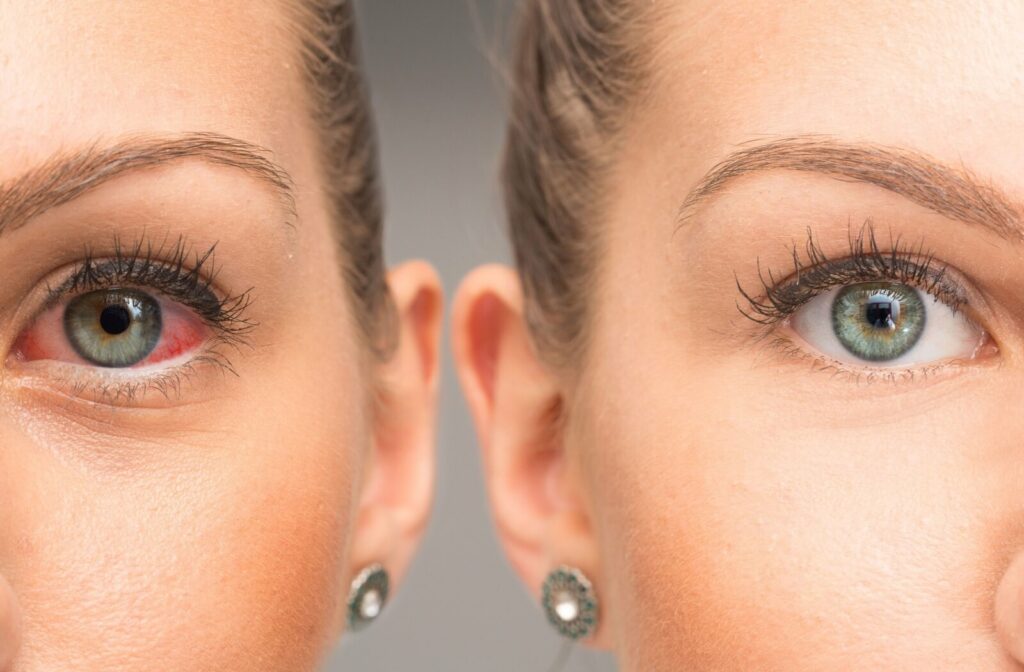If you’re contemplating Intense Pulsed Light (IPL) therapy for your dry eyes, you may have some questions about side effects. Mild discomfort, redness, and temporary swelling are occasionally experienced side effects following IPL therapy for dry eyes.
IPL is performed in an office with an optometrist or ophthalmologist. As with most medical procedures, it comes with some small risks and should be performed by a professional. Let’s explore IPL for dry eyes, what the treatments entail, and what you can expect.
Illuminating IPL for Dry Eyes: The Science of Relief
Originally used in dermatology, IPL emits various wavelengths of light to target hemoglobin and melanin, which may be overexpressed in inflamed meibomian gland tissues associated with dry eyes. By selectively heating and treating these areas, the goal is to unblock the glands and improve blinking function to restore the eye’s natural lubrication. The procedure involves a series of brief pulses and can feel similar to the snapping of a rubber band against the skin near the eyes.
A typical treatment regimen involves multiple sessions, times about a month apart spread out over several months. Each session lasts approximately 15 to 20 minutes. During the procedure, you will wear protective eyewear to shield your eyes from the intense light pulses.
The number of treatments needed varies based on the individual’s severity of dry eye symptoms and response to the therapy. Some people report significant improvement after just one or two sessions, while others may require additional treatments to achieve desired results. You may require treatments every 3-6 months to maintain your results.
Side Effects of IPL
The potential side effects of IPL can include:
Mild discomfort: During and immediately after treatment, a stinging sensation similar to a mild sunburn might be felt.
Skin and eye irritation: Some people experience some redness of their skin and their eyes may water.
Light sensitivity: Photophobia can be temporarily exacerbated, sunglasses may be needed until it subsides.
Swelling: Some people may experience swelling of the area that was exposed to the light.
Hair loss: A result of IPL may include hair loss around the eye where the light was focused.
Duration of Side Effects
The good news is that these side effects should dissipate within hours or a couple of days after treatment. Any prolonged discomfort would warrant immediate assessment with your eye doctor.
Keep in mind that many people undergoing IPL therapy require multiple sessions to achieve the best results in their dry eye relief. Any side effects should be similar each session, but consider the regularity and cumulative effects if they do appear.

Daily Life Post-IPL
Following an IPL session, taking life at a slower pace for a day or two can enhance recovery. This means:
- Avoiding excessive screen time
- Avoid applying eye makeup.
- Keep a clean and sanitary environment around the eyes.
- Protect the eyes from environmental irritants.
- Resist the temptation to rub the eyes
Prioritize hydration and nutrition that support eye health. Incorporating foods rich in omega-3 fatty acids, such as fish, flaxseeds, and walnuts, can naturally enhance the eye’s moisture. Drinking plenty of water throughout the day also plays a critical role in maintaining overall hydration, which is beneficial for dry eyes.
Driving After IPL Treatment
For most, the light sensitivity and associated discomfort are a non-issue. It’s vital to gauge your reaction to the treatments and rely on your judgment. It may be beneficial to have someone else drive you home initially, to determine if you would be comfortable driving yourself after the next treatment.
Who Should Not Get IPL for Dry Eyes
Certain people may need to consider alternative treatments, based on some factors:
Skin Conditions: Presence of skin infections, active acne, or a history of poor wound healing.
Pregnancy or Nursing: Lack of research on the effects of IPL in these conditions.
Photosensitizing Medication Usage: These medications can increase sensitivity to IPL light pulses, leading to adverse effects.
Severe Rosacea or Eczema: Inflammatory skin conditions that could be exacerbated by IPL treatments.
Darker Skin Tones: Increased risk of pigmentation changes post-IPL.
Use of Accutane: Individuals who have used Accutane in the past six months may face increased risks during IPL treatment.
Tendency for Keloid Formation: Those prone to keloids might experience problematic scarring.
Consult with your eye doctor to accurately assess whether you would be a good candidate for IPL.
Key Takeaways
- IPL therapy can offer relief for dry eye symptoms by targeting inflammation in the meibomian glands.
- Mild side effects like redness, discomfort, or swelling are common but typically resolve within a few days.
- Multiple treatments are often needed, spaced about a month apart, with potential maintenance sessions every 3–6 months.
- Not everyone is a candidate, factors like certain skin conditions, medications, or skin tone can influence eligibility.
- Post-treatment care includes avoiding eye makeup, limiting screen time, staying hydrated, and protecting the eyes from irritants.
- Always consult with your eye doctor before beginning IPL therapy to determine if it’s the right choice for your condition.
Get Dry Eye Treatment in Prosper
The decision to undergo IPL for dry eyes must be an informed one, weighing personal comfort, the risks, and the benefits of treatment. At EyeDeal Eyecare, our dedicated team is here to help you navigate the treatment options. We offer specialized treatments for dry eyes including IPL. Schedule an appointment today to learn more about if IPL can help you with your dry eyes.




